Author: Jobia Keys
My four-year-old daughter received a Barbie as a gift – one that looked like her, a pretty brown one (as she said). She asked me to come in her room because she had a question. She had a concerned look on her face as she asked me, “Is this a realBarbie?” I asked her what she meant by realBarbie, because “of course, it’s real,” I told her. I asked her, “Why do you think this Barbie isn’t real?” She said, with such a confident face, “Because she is brown.” All at once, my stomach crashed to the floor and my heart cried. I couldn’t believe that this beautiful girl, who has been raised to see people equally, to know that her value as a brown girl is equal to the value of white, black, yellow and tan girls, just questioned the authenticity of her new brown Barbie. I wanted to know why she would think such a thing. She told me that whenever she sees Barbie on commercials, shows or videos, she is always white. At that moment, my darling daughter proved that children, even as young as preschool-age, recognize and have some understanding of media images and the messages those images create.
Children are exposed to one dimensional portrayals of race, gender, class and other identities in all channels of media specifically created for them. One area of media, which is particularly concerning, is the lack of diversity in advertisements for toys and games aimed at young girls. Generally, the actors featured in the commercials are white, seemingly middle-class girls. I’ve been aware of this disparity for a very long time, however, now that I have a daughter who enjoys playing with dolls, this issue has been at the forefront of my mind. We are inundated with media images on commercials, websites, billboards, magazines, books, and more, everyday. I do not think the consumerism and commercialism that engulfs our world is going to go away, but I do think that major brands should be held accountable for their lack of diversity when selling toys to young girls.
It is important to recognize the strides Mattel has taken in creating their “Career Dolls,” which feature dolls as Doctors, Veterinarians, Nurses, Chefs, Game Developers, Film Directors and more! However, when it comes to the diversity of their doll offerings, Barbie needs tremendous improvement. When is the last time you saw an Asian American, Native American or Latina Barbie in the toy aisle? What about in one of their advertisements? These dolls and mediated images are even more scarce than African American dolls and images.
Because of the lack of diversity in the doll industry, companies have created dolls that look like brown and yellow and tan girls (see my list below of companies with diverse dolls). The emergence of these companies prove that people are not going to sit around and wait for Mattel and other toy companies to properly address these issues and market to increasingly diverse consumers. It is important for Mattel to embrace diversity, not just in their doll collection, but in their advertisements, television and video characters and book characters. Until Mattel recognizes this very sad display of inequity, I will not purchase or even accept any of their products as gifts. I have also urged my family and friends to do the same. Research has shown that children who do not see images of themselves in media (people who look like them), may have lower self-esteem. Mattel’s and other toy companies’ preferment of whiteness in dolls and advertisements aimed at young girls is archaic, disturbing and wrong. But we, as consumers, have other options. I encourage you to consider those other options and choose a beautiful doll that reflects the beauty in your little one!









